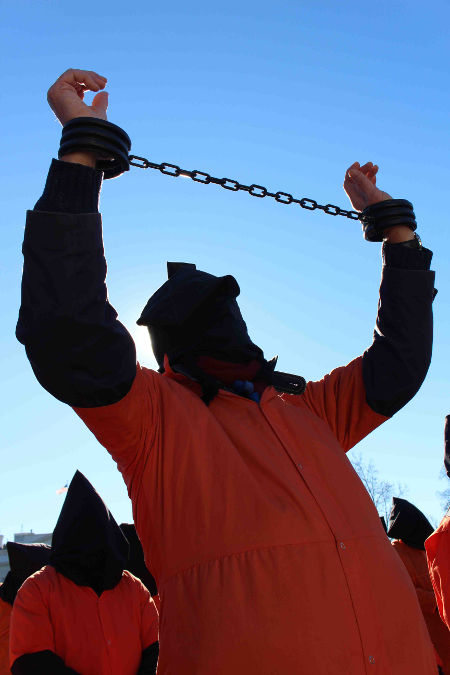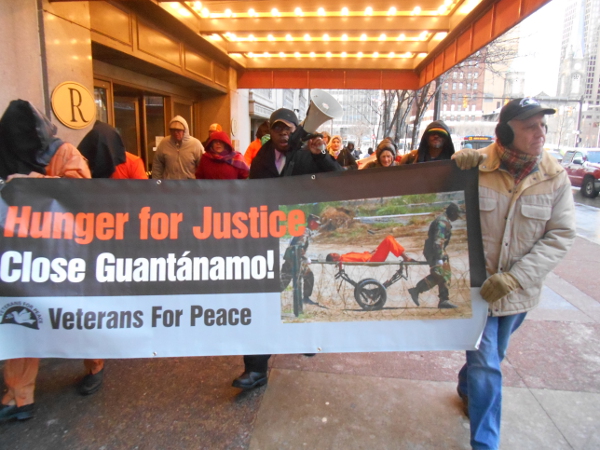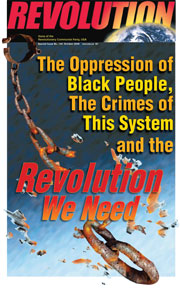Protests in U.S., London, and Mexico City Demand: Shut Down the U.S. Torture Camp at Guantánamo
by Debra Sweet, Director of World Can’t Wait | January 18, 2016 | Revolution Newspaper | revcom.us

On the 14th anniversary of Guantánamo, protesters represented for the prisoners wearing orange jumpsuits and black hoods, from the White House gates to the West Coast, chanting and challenging passers-by with leaflets. Photo: Eleanor Goldfield/Art Killing Apathy
Protesters across the U.S. and at U.S. embassies in London and Mexico City last week demanded the closure of the U.S. torture camp at Guantánamo Bay first set up by the Bush regime on January 11, 2002. The camp has operated seven years under Obama, as long as it did under Bush, though Obama promised in 2009 to close it within a year. Guantánamo forms part of a larger, global network of prisons set up by the United States after 9/11, an integral part of the limitless global “war on terror” necessary to spread the U.S. empire of capitalist-imperialist globalization exploiting billions worldwide.
The Bush regime brought 779 Muslim men to the military base. Most were captured in Afghanistan or Pakistan, many sold for $5,000 bounty to the U.S. military. Guantánamo exists explicitly to avoid the protections of legal process in the U.S. Constitution. Those held are called “unprivileged enemy belligerents,” not prisoners of war, so they can be held without benefit of the Geneva Conventions, which give rights to those captured in war.
Less than 2 percent (15) of Guantánamo prisoners have ever been charged with anything. Right now 93 remain, including 34 men who have been “cleared for release” but are not allowed to return to their countries. The largest group remaining are the so-called “forever” prisoners, those the U.S. government claims are “too dangerous” to release but says it does not have enough evidence to charge. Attorneys for the prisoners point out that avoiding trials also avoids releasing evidence of the torture most were subjected to.
The prisoners endured years of physical torture and the psychological torture of being isolated and never knowing if they would be released. Among many abuses, prisoners in Guantánamo suffered waterboarding and other torture techniques approved by the Bush White House; years of solitary confinement; deprivation of family and attorney contact; invasive genital searches and beatings. Their meetings and communication with assigned attorneys were spied on; the CIA recruited members of prisoners’ legal teams. The Obama administration opposed legal action in U.S. courts brought by prisoners, including habeas corpus challenges to their confinement. The Pentagon interfered with plans to release prisoners by not providing host countries with medical files, or by just refusing to negotiate the details for years.

Cleveland, January 12—people marched in the freezing cold through downtown, chanting “Close Guantánamo/Shut It Down.” There were people from Cleveland Revolution Club, Veterans for Peace, Freedom First International, the Catholic Worker Movement, Council on American-Islamic Relations, and other peace activists. Before the march interfaith and community activists came together to speak on “Challenging Islamophobia.”
Photo: revcom.us/Revolution
The ten Yemeni prisoners released on January 14, 2016 had been “cleared” for years, but since the U.S. is backing the Saudi war on Yemen, they were sent to Oman, a U.S. ally. One of those men, Samir Naji al Hassan Moqbel, arrived the day the prison opened. He participated in the prisoner hunger strike of 2013, an action which drew world attention to the brutal force feeding of prisoners by the military. In an op-ed column published in the New York Times, “Gitmo is Killing Me,” Moqbel wrote, “When they come to force me into the chair, if I refuse to be tied up, they call the E.R.F. (Extreme Reaction Force) team. So I have a choice. Either I can exercise my right to protest my detention, and be beaten up, or I can submit to painful force-feeding.”
The Obama administration has indicated it still has plans to close Guantánamo by moving the “forever” prisoners and those it plans to put on trial to the U.S. mainland, possibly to military prisons. Some attorneys for the prisoners say that holding people without charge or trial within U.S. borders could establish a precedent of indefinite detention within the U.S. Ramzi Kassem, a professor at the CUNY School of Law, who has represented 13 of the prisoners, said last year, “Guantánamo was never a single prison facility. From the beginning, it was always an idea, an ideology that purportedly liberated the U.S. government from the fetters of domestic and international law.... When people call for Guantánamo to be closed, it is simply shorthand for a more comprehensive demand to end torture and arbitrary, indefinite imprisonment without trial or fair process.”
“Guantánamo is a legal, moral and ethical abomination, and every day it remains open [it] poisons the U.S.’s claims to be a nation that respects the rule of law,” said Andy Worthington, a British activist journalist who led the campaign to Stand with Shaker Aamer, the last British resident in Guantánamo, and leader of prisoners’ resistance efforts. On January 14, Worthington spoke at Revolution Books New York on the successful battle to get Shaker released, after being cleared for release twice, in October 2015. Campaigners made a 14-foot tall “inflatable” Shaker and worked to get over 100 celebrities and politicians to have their photos taken with the inflatable Shaker, demanding his release. Aamer and five men who had also been detained in Guantánamo protested on January 11 at the U.S. embassy in London, demanding its closure “for everyone, not just for the brothers who are left there.”
Volunteers Needed... for revcom.us and Revolution
If you like this article, subscribe, donate to and sustain Revolution newspaper.







